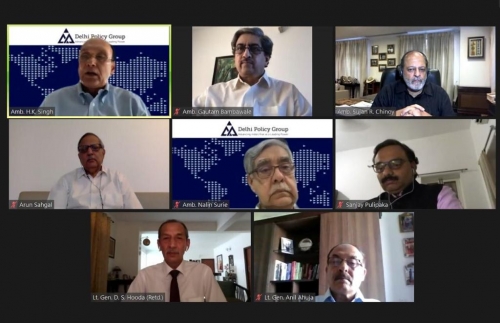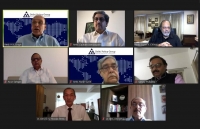India- China Border Standoff
On June 10, 2020 the Delhi Policy Group hosted a Webinar on the ongoing India-China Border Standoff. The Webinar was moderated by Brig. Arun Sahgal and the panelists included Amb. H.K. Singh, Lt. Gen. Deepak Hooda, Amb. Gautam Bambawale and Amb. Sujan R. Chinoy. The backdrop was China’s military intrusions at multiple locations in Ladakh and Sikkim with the pre-meditated intent of coercive intimidation for regional dominance.
The panelists deliberated on the multidimensional nature of Chinese transgressions across the LAC and India’s diplomatic/military options to address the standoff. Other developments, such as Beijing’s reported unease with India’s infrastructure development on its side of the border, consequences of the Doklam standoff in 2017 and India’s decision to restructure Jammu and Kashmir and Ladakh as Union Territories in August 2019 were evaluated.
The domestic compulsions of Chinese leaders to showcase military strength at a time when Beijing is under pressure from the international community were examined. China’s strategy of portraying India’s weakness to its neighbours in South Asia and the possibility of a China-Pakistan-Nepal axis to constrain India’s options in the region was discussed.
The impact of PLA modernisation and the emergence of its combined brigade structures, a robust marine arm, strengthened rocket forces, and enhanced cyber/space/non-kinetic capabilities was evaluated in relation to India’s military posture along its Himalayan borders.
It was noted that Delhi needs to update its border management with specific reference to infrastructure building and enhanced synergies between the ITBP and the Army for more effective operations. To address the power asymmetry vis-à-vis China, India needs to have a clearly articulated National Security Strategy and a corresponding National Defence Strategy covering continental and maritime domains. India should also consider integration of its conventional and strategic deterrence strategies given the nature of China-Pak collusion.
It was further suggested that India should become less reticent about enunciating its views on unrest in Xinjiang, Tibet and Hong Kong. The role of India’s strategic partnerships in terms of defence and security capacity building was touched upon.
From an Indian perspective, nothing short of the restoration of the status quo ante will be an acceptable solution to the current standoff, utilising existing military and diplomatic mechanisms for border management and tranquility. As a longer-term response, India must revive its economy, enhance its defence budget and adopt a whole-of-nation approach to meet the growing adversarial challenge from China.



